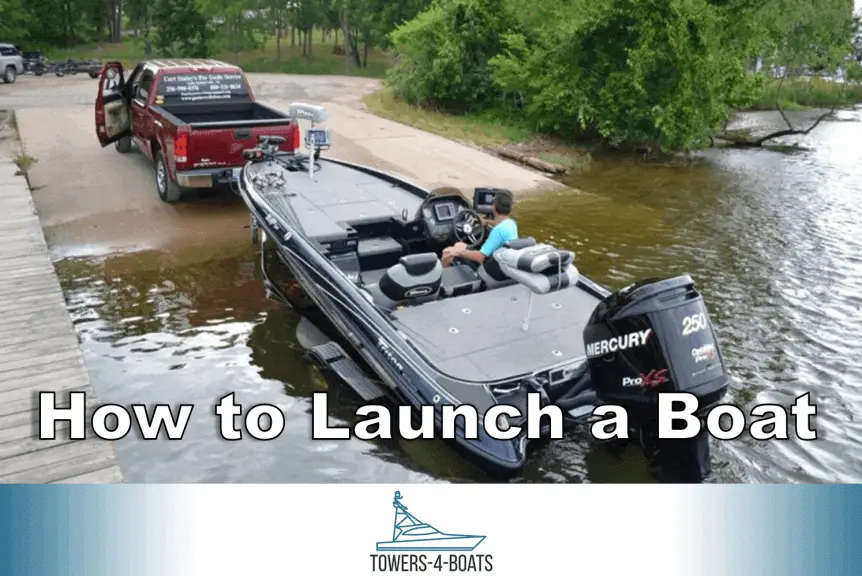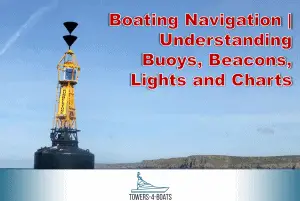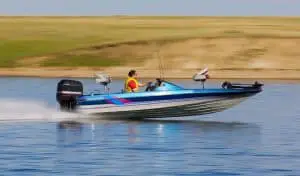After spending the time to find the perfect boat for you and your family (and maybe even your friends), you are ready to get out on the water to have some fun. However, before heading out, you’ll need to know how to launch your boat.
Launching Your Boat
It may seem like launching your boat should be an easy task. In theory, it is, but there are also many factors you have to consider when putting your boat in the water. These included things like the ramp you are launching from—if there’s a ramp at all—whether you have help with the process and the type of boat you are launching. Below are some tips and information to help you with the boat-launching process.
Launching a Boat Alone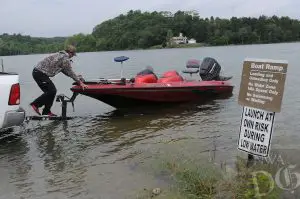
Launching a boat by yourself can be a daunting process. If you have a friend or family member with you, they can guide you and let you know if you are lined up properly to approach the water. When you are by yourself, you have to take on these duties alone. However, this is a task you can master.
Step 1: Pull Off to the Side to Get the Boat Ready
The first thing you’ll need to do is make sure that your boat is ready to go. This includes having all the necessary gear in your boat, including coolers, fishing poles, chairs, safety gear and anything else you might need. Once you have gotten those in the boat, you can then head to the ramp to launch.
Step 2: Back Down the Boat Ramp
When the ramp is clear, you can then back your boat down the ramp. Use your mirrors to ensure that you are inline with the ramp and the water. Before your boat is fully submerged, you’ll need to stop and disconnect the winch strap. Make sure to your truck in is park and the emergency brake is on.
While you are disconnecting the winch strap, you can take a look at your position to ensure that you are headed straight for the water. You’ll also use this time to secure your dock line to the bow cleat and trailer—you don’t want your boat floating away while parking your vehicle. Then, you’ll climb back into the vehicle to back it the rest of the way into the water.
To make sure you are far enough to launch your boat, you’ll need to make sure your back wheels are wet and the boat is in the water. You will then give your brakes a firm, quick press. The goal here is to break the tension between the boat and the trailer, popping it off so that it is floating on the water. The bowline should prevent it from floating too far from shore.
Step 3: Tie Your Boat to the Dock
Once your boat is in the water, you will once again climb out and tie it to the dock (if there’s one present) or secure it in another way close to shore. This could mean tying it off to a rock or tree. After you have moved the boat away from the trailer and secured it, you can then park your truck and enjoy your day boating.
Before you get out of your car, watch this video on “What Not to Do”
(Hint – Use wheel chocks to keep your car from rolling into the water)
Launching a Boat from a Dock
If you had the opportunity to tie your boat to the dock, this will make it much easier to climb into your vessel and get it onto the water. Before pulling away, you’ll need to make sure that you untie it. Once those have been released, your boat should float away from the dock. If not, then you can gently push yourself away.
You’ll need to find out how deep the water is in this area to determine if you can use your engine and prop to back away from the dock. If it’s not very deep, then using your oars will be in your best interest. Place it in the water and push yourself into deeper water so you can use your engine.
Once you have reached deeper water, put your engine in reverse and turn it on low. Most docks and boat ramps are no wake zones, which means that you can’t create waves with your motor. Once you have moved out of the area, you can then turn your boat toward your intended destination and crank up the engine to have some fun.
Launching a Boat off a Beach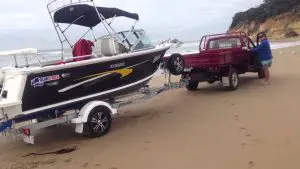
If the location you are launching from doesn’t have a boat ramp, this will make matters a bit more challenging, but definitely not impossible. Below are the steps you can take to get your boat in the water from the beach.
Step 1: Check the Area
Before backing your boat toward the water, you want to check the area. This will give you the chance to see how hard or soft the sand is. The last thing you want is to get the tires of your vehicle buried in soft sand. If possible, pay attention to where others are launching from or talk to locals to find the best location.
Step 2: Unhook the Boat
Before getting the trailer fully submerged in the water, you’ll want to stop and unhook the winch wire. Depending on the type of trailer you have, you’ll have to time this step perfectly. If you have a multi-roller trailer, which makes it incredibly easy to slide your boat on and off, you don’t want to do this step too soon. That may leave your boat sitting in shallow water, making it difficult to get into the water.
With multi-roller trailers, back your boat far enough into the water so that it is floating but you still have the ability to pull your vehicle out. Then, you can unhook the winch wire. Remember that you will need to secure to boat to something on the beach as well as pull it as far onto the sand as possible. If you don’t, you risk your vessel floating away.
If you have a padded or bunk trailer, these aren’t actually recommended for beach launching because they require you to back so far into the water to be able to get your vessel free. However, if you don’t have another trailer, then you’ll have to make this work.
The best course of action to take in this case is to back your boat trailer and vehicle into the water as far as possible without getting the vehicle stuck. Then, you’ll unhook the trailer from the vehicle and manually push it into the water until the boat floats. You can then unhook the winch wire and secure the boat so that it won’t drift away.
Step 3: Get Away from the Beach for Some Fun
With the beach launching process, there’s really no way to keep from getting wet. When you are ready to get your boat away from the beach and into deeper water, you’ll need to untie it and then push it farther into the water. Once it is free of the sand and floating on its own, you can then put the engine in reverse and turn it on low until you reach deeper water.
If the water isn’t deep enough for you to use your engine, you’ll need to use your oars to get you into deep enough water that will allow you to use your engine.
Complicating Factors and Challenges
When it comes to getting your boat into the water, while the process can be relatively simple, there are some factors that will make boat launching challenging. Three of these are listed below.
Low Tide or Shallow Water
If the water isn’t deep enough, your boat won’t be able to float on its own. This could mean that you will have to back your vehicle and the trailer a long way across wet sand to launch your boat, or you will have to use manual pushing power to get your boat into deep water. Before backing into the water, survey the area to determine find the most stable sand so that you won’t get your vehicle or trailer stuck.
Steep or Shallow Ramp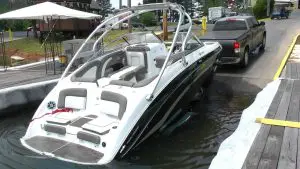
The issue with a steep ramp is that it can become incredibly slick when it gets wet. If you don’t have good traction on your tires, the momentum and weight of your boat will pull your entire rig into the water. If you are faced with a steep ramp, the best way to get your boat into the water is to take it slow and ensure that you have great traction on your tires.
Another problem you might encounter with a steep ramp is an abrupt stop at the end. Instead of gradually inclining into the water, your trailer might be driven directly into the sand. When this occurs, it can make it challenging to get your boat to float. To overcome this issue, if possible, you may have to approach the water at an angle so that you can get your boat free of the trailer.
This may also be the case if you are working with a shallow ramp. Once again, you might also have to use manual pushing power and unhook the trailer from your vehicle to get your boat into the water.
Big Boat
If you have a large boat, this can also make it challenging to get it into the water. Before launching, make sure the ramp can accommodate the size. If so, the best way to accomplish this task is to take it slow and be aware of your surroundings. Knowing where the edges of the ramp and your trailer tires are at all times will ensure that you don’t fall off the edge.
Type of Boat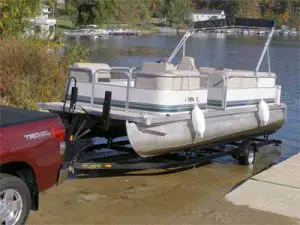
The type of boat you have will also play a role in how you launch it. When it comes to a pontoon or fishing boat, following the above tips and tricks is the best way to get it into the water. If you have a sailboat, most of the same processes listed above can be used, but since you don’t have an engine, you’ll have to rely on your oars to get you into the water.
You’ll also have to worry about the wind when launching a sailboat. You’ll need to know which direction it’s blowing so you can move away from the shore and not have it blow you into the sand.
The most important thing to remember when launching any type of boat is that its natural place is in the water. Thus, when the water is deep enough to allow it to float, it will do just that. Always make sure to have it secured before fully removing it from the trailer. Otherwise, you may have to swim after your vessel.
Etiquette
When it comes to launching your boat, there is some etiquette you need to follow, especially if you are launching from a boat ramp. Keep in mind that you are not the only person who needs to use this, so being kind and courteous to others is a must.
Know the Rules
Find out if there are any rules that pertain to the particular boat ramp that you are using and obey them. If the ramp can only accommodate boats of a certain size and yours is larger, don’t try to launch your boat from that area. This could wind up getting you fined or damage your vessel.
Load Your Gear Beforehand
Make sure you load all of your gear beforehand. This includes anything you’ll need on the water, including fishing poles, coolers, cameras, extra clothes, safety equipment—whatever! You don’t want to hold everyone else up by putting your boat in the water and then loading your belongings.
The same is true when you pull your boat out. After you have gotten your boat on the trailer and out of the water, pull it out of the way and park, and then remove your belongings from the inside of the boat.
Fun in the Sun
Taking your family and friends out on the boat can be a great way to spend the day. One of the most challenging tasks will be launching it, but it’s not an impossible feat. Knowing what you are getting into will help you be prepared to conquer this task like a pro.

